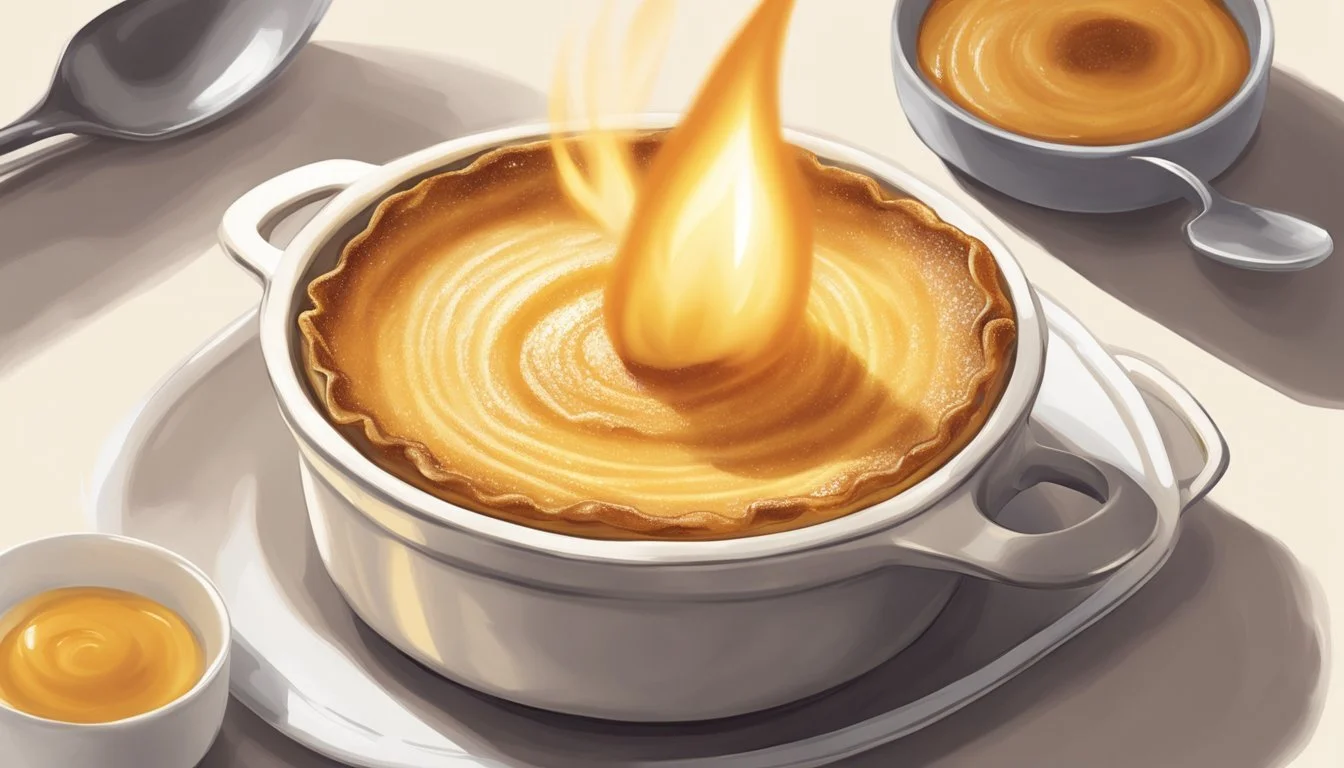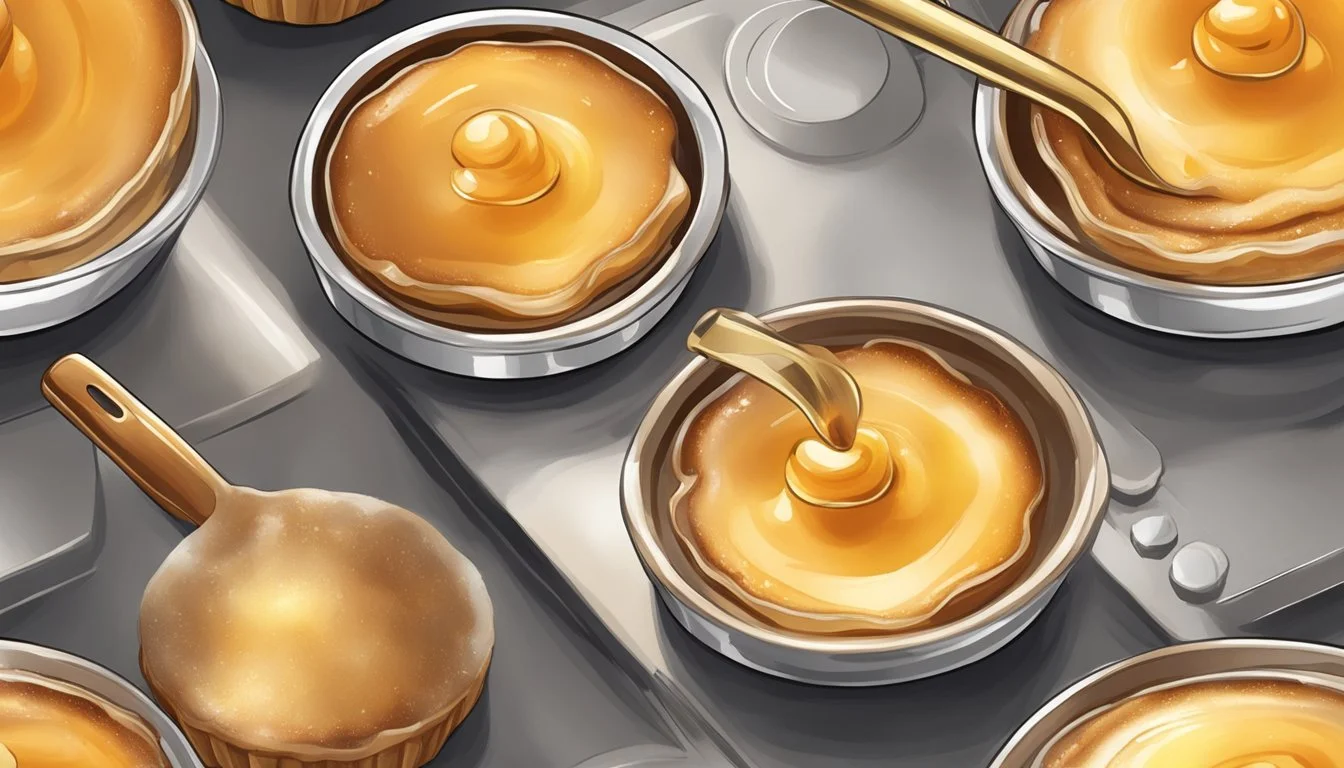Best Way to Reheat Crème Brûlée
Keeping the Top Perfectly Caramelized
Crème brûlée, with its rich custard base and contrasting layer of hard caramel, is a quintessential French dessert cherished for its blend of textures and temperatures. The caramelized top, a signature feature, is typically achieved by sprinkling sugar over the custard and using a culinary torch or a broiler to melt and brown the sugar until it forms a shiny, crisp crust. This prized texture contrast is what makes crème brûlée a standout dish, and preserving this quality in leftovers can be a challenge.
Reheating crème brûlée requires gentle care to maintain the integrity of its silky custard without melting the brittle caramelized sugar on top. The process must be handled with precision to ensure that the dessert is warmed through just enough while keeping the caramel crust intact. Understanding the delicate nature of this French classic is crucial for anyone looking to enjoy a previously chilled crème brûlée as if it were freshly made.
There are various methods suggested for warming crème brûlée, including the use of an oven or an air fryer, and each technique comes with its own set of considerations to prevent the dessert from becoming too runny or overheated. The key is to find a balance that allows the custard to reach the perfect temperature so that its texture remains creamy and luscious, while the caramelized top stays firm and crackly, delivering the contrasting delight that crème brûlée is known for.
Understanding Crème Brûlée
Crème brûlée is renowned for its rich custard base topped with a contrasting layer of hard caramel. Knowing its composition and the significance of the caramelized sugar topping is crucial to maintaining its unique texture and taste when reheating.
Composition of Crème Brûlée
Crème brûlée is composed primarily of a smooth, creamy custard. The custard is traditionally made with heavy cream, egg yolks, sugar, and vanilla. During preparation, the heavy cream is infused with the vanilla flavor, often derived from a vanilla bean or vanilla bean paste. The rich flavor of the dessert primarily comes from the high-quality ingredients and the method of gently cooking the mixture to achieve the perfect consistency.
Ingredients:
Heavy Cream
Egg Yolks
Granulated Sugar
Vanilla (bean or paste)
Texture: Creamy, thick custard
The role of the egg yolks is pivotal; they not only contribute to the creamy texture but also give the custard its characteristic yellow hue. After blending the ingredients, the mixture is poured into ramekins and cooked at a low temperature until it sets, resulting in a delicate balance of taste and texture.
Importance of the Caramelized Sugar Topping
The caramelized sugar topping of crème brûlée is more than just a decorative finish; it adds a unique flavor and a textural contrast to the creamy custard beneath. This topping is achieved by sprinkling granulated sugar over the cooked custard and then using a culinary torch to melt and brown the sugar until it forms a hard, glass-like layer.
Caramelized Topping:
Granulated Sugar
Cooking Torch (or broiler)
Upon cooling, this layer becomes the dessert's signature brittle top, which should crack when gently tapped with a spoon. The caramelization of the sugar not only imparts a rich, toasty flavor but also provides an experience that is both taste and touch, distinguishing crème brûlée from other custard-based desserts (What wine goes well with desserts?).
Reheating while Preserving Quality
In reheating crème brûlée, one's primary goal is to warm the custard without melting the caramelized top into a soggy layer. Precision in technique and a careful approach will ensure that the dessert maintains its textural integrity and indulgent taste.
Reheating Techniques
Using the Oven Broiler:
Pre-warm the broiler to a moderate heat.
Place the crème brûlée on the oven's middle rack to avoid direct heat on the topping.
Heat briefly, monitoring closely to prevent the crispy topping from burning. The aim is to achieve a gently warmed custard.
Kitchen Torch Method:
If the dessert is cold, let it sit at room temperature for approximately 20 minutes before using a kitchen torch.
Wave the torch back and forth near the surface to slightly warm the topping without making it runny.
The torch can be used to crisp up the topping after reheating if it isn't sufficiently crispy.
Avoiding Common Reheating Mistakes
Oven Temperature Too High:
Do not set the oven or broiler too high as this can cause the topping to bubble and liquefy, losing the crispy feature that defines a crème brûlée.
Overheating:
Reheat until the crème brûlée is just warm to the touch. Overheating can make the custard too runny.
Use a thermometer to check that the internal custard temperature doesn't surpass a moist and warm consistency.
Uneven Heat Distribution:
Rotate the ramekin halfway through reheating to ensure even distribution of warmth.
A blowtorch can be meticulously directed around the topping for an even finish if using after reheating.
By adhering to these specific reheating methods and avoiding common errors, one ensures a high-quality, restaurant-like dessert experience at home.
Preparing for Reheating
Ensuring the quality of crème brûlée when reheating starts well before the dessert goes into the oven. Proper pre-reheat storage and setup are crucial to maintain that delectable, crisp sugar topping and the creamy custard below.
Pre-Reheat Storage
Crème brûlée should be refrigerated shortly after it's initially prepared and cooled to room temperature. This is especially important if it is a make-ahead dessert or leftovers. Store the individual ramekins covered with either plastic wrap or aluminum foil to protect the custard from absorbing any fridge odors and from forming a skin on the surface. Crème brûlée should never be frozen as it can compromise the texture and consistency of the custard.
Setting up for Optimal Reheating
Before reheating, take the crème brûlée out of the refrigerator and let it sit until it reaches room temperature. This step ensures even reheating and reduces the risk of the ramekins cracking from temperature shock. Once at room temperature, place the ramekins on a baking dish, keeping them level to avoid spilling. The ramekins must come to room temperature before reheating to prevent the custard from heating unevenly.
Serving Recommendations
When serving reheated crème brûlée, the presentation is nearly as vital as the flavor. The goal is to enhance the experience while keeping the spotlight on the dessert's creamy texture and signature caramelized crust.
Accompaniments and Garnishes
Crème brûlée can be served with a variety of accompaniments and garnishes that complement its rich flavor:
Berries: Fresh raspberries or a mixed berry assortment provide a refreshing contrast to the dessert's sweetness. They add a splash of color and flavor.
Whipped Cream: A dollop of lightly sweetened whipped cream can add a soft, airy texture.
Powdered Sugar: A light dusting of powdered sugar can decorate the plate without overpowering the dessert.
These add-ons should be fresh to ensure the finest taste and presentation.
Presentation Tips
The presentation of crème brûlée should accentuate its elegance:
Dishes: Serve in the original ramekin to maintain the crispy top and creamy base.
Espresso Powder: For a subtle coffee flavor, a pinch of espresso powder can be sprinkled around the plate.
Contrast: Utilize color contrast, such as a dark plate for vanilla crème brûlée, to make the dessert stand out.
Maintain simplicity in presentation to keep the crème brûlée as the centerpiece of the dining experience.
Maintaining Texture and Flavor
The integrity of a crème brûlée's texture and flavor hinges on the method of reheating. Precision ensures the delicate custard remains silken and the sugar top stays satisfyingly crisp.
Key Factors Affecting Texture
When reheating a crème brûlée, it's crucial to avoid turning the creamy custard into an overcooked flan. The custard, made with ingredients like heavy whipping cream and egg yolks, is sensitive to high temperatures. Salt is a minor but vital component, which needs to be in balance to prevent a texture that's either too firm or too runny. The following steps should be observed:
Temperature Control: Reheating should be done gently. An oven set to a low temperature, around 300°F, can efficiently warm the dessert without overcooking the edges.
Timing: It typically takes about 10 to 15 minutes to warm through the custard without altering its smooth consistency.
Enhancements for Flavor
Flavoring the custard with additives like vanilla or lemon zest must be done during the recipe’s initial preparation to infuse the mixture with subtle, yet discernible notes. However, during reheating, to maintain the quality of these delicate flavors:
Avoid High Heat: High temperatures can degrade the subtle flavors. Low and slow reheating preserves them.
Caramelized Top: After reheating the custard, one may need to refresh the turbinado sugar topping with a kitchen torch to restore the trademark burnt sugar taste and texture.
Additional Tips and Tricks
To ensure the finest results when reheating crème brûlée, one must consider the use of alternative sweeteners and innovative variations to the classic recipe. The following subsections provide specific advice that can enhance the reheating process and offer a delightful twist to this exquisite dessert.
Using Alternative Sweeteners
When reheating crème brûlée at home, chefs might find that using superfine sugar for the caramelized top can lead to a more even melt. Superfine sugar melts more readily than regular granulated sugar, ensuring that the caramelization process is smooth without overheating the custard. For those interested in a richer flavor, pecans or walnuts can be ground into the sugar to add a nutty note.
Temperature is key: It is imperative to use a thermometer to avoid overcooking. By carefully monitoring the temperature, one ensures not to alter the silky texture of the custard.
Tools to use: A sieve can be helpful when sprinkling the alternative sweetener evenly across the surface before caramelizing.
Creative Twists on Classic Crème Brûlée
Creative bakers often like to go beyond the traditional recipe by incorporating elements such as espresso or tiramisu flavors into their crème brûlée. When making the custard for such variations, the addition of quality espresso can offer a sophisticated touch.
Pairing with cookies: Serving the reheated crème brûlée with homemade meringue cookies complements the creamy texture and adds a crunchy contrast.
Ramekin choice: Opting for shallow ramekins enhances the surface area, allowing for more of that beloved caramelized top.
One must refrain from altering the core ratio of milk to eggs when adding these elements, as it is vital for the dish's success. Achieving the perfect consistency means carefully tempering the egg mixture when incorporating hot liquids, like espresso, into the milk. This will prevent the eggs from curdling and ensure a smooth custard. A water bath during the initial baking is essential, as it moderates the temperature and cooks the custard evenly, setting the stage for a successful reheating.







